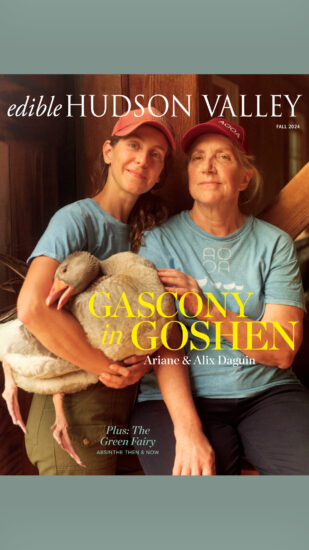As artists, Allyson Levy and Scott Serrano followed parallel paths that converged in the garden. A married couple with grown children, they are also the founders of Hortus Arboretum & Botanical Gardens, a Stone Ridge-based plant repository with a mission to be a “living textbook” of plant life capable of thriving in the Hudson Valley. It offers a wealth of practical knowledge of more than a thousand different types of plants and trees from around the world.

The project began in 2001 as an informal planting of tupelo, spicebush, and tulip trees to attract the American silk moths featured in Scott’s drawings, along with hydrangeas, poppies, euphorbias, milkweeds, and viburnums, whose petals, leaves, and seeds Allyson combines with encaustic wax in her paintings.
RELATED: Get Exotic (Hortus’s top picks for shrubs and trees that thrive in the Hudson Valley)
As their individual work evolved, so did the plants they wanted to grow, until the garden itself turned into a primary passion. They became increasingly interested in expanding the list of what is generally considered hardy in this area (somewhat loosely identified as zone 6). More than half of what they now grow is edible and many of the plants and trees are non-natives from Asia or Europe, producing wonderfully exotic fruits and nuts not commonly seen in these parts. Even the native fruit-bearing trees they feature—such as persimmon and pawpaw—are no longer readily available in most local nurseries.

Hortus (as it’s informally known) offers classes, talks, and tours that aim to educate and inspire the general public about lesser-known plants. They offer tastes of fruits in season, as well as teas and beverages made from plants in the garden, including sweetfern (Comptonia peregrina), schisandra (Schisandra chinensis), and sea buckthorn (Hippophae).
“The range of ornamental and edible plants available for sale through nurseries has been reduced to a handful of familiar and recognizable varieties—what are considered the tried-and-true cultivars,” explains Allyson. “We encourage folks who want an early spring shrub to look beyond forsythia and consider alternatives with beautiful flowers, like Cornelian cherry (Cornus mas) and spicebush (Lindera benzoin).” These also produce edible aromatic berries that appeal to both people and wildlife.

In addition to being an “experimental edible station,” Hortus (Latin for “garden”) is an exercise in mindfulness. “Beyond anything you know or any skills you have as a grafter, it’s really about being patient,” says Scott. “That runs counter to a lot of American gardening, in which people expect to go into a store, buy something that’s eight feet tall, stick it in the ground, and— boom!—have it be ready.”
Part of what he and Allyson enjoy, and what every gardener comes to understand as essential to success, is forging a relationship with the plants over time. Watering by hand, crouching down to feel the soil, nurturing a seedling during the weeks, month, and years that it takes to become established and flourish—all this may one day coalesce in a deeply fragrant quince or a rich handful of Korean stone pine nuts.
Rare plants that Scott has raised from seeds and cuttings are offered for sale during Hortus’s open garden events. The first one of the season is typically held on Memorial Day weekend. Until then, plant lovers can eagerly anticipate visiting the Chinese Explorer Garden, the Southwestern Desert & Cactus Bed, and the collection of unusual, shade-tolerant hydrangeas. Gourmands can dream about the creamy custard-apple flavors of the pawpaw and the vibrant tang of Arctic kiwis. Gardeners, start your engines!



South Gardens from above
This story was originally published in our Spring 2019 issue.



